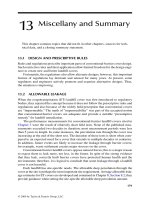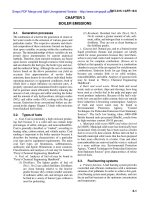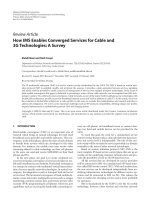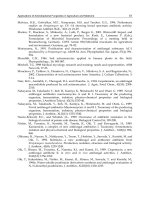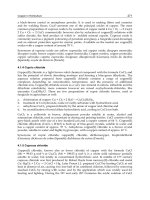Ship Stability for Masters and Mates 5 Episode 5 ppt
Bạn đang xem bản rút gọn của tài liệu. Xem và tải ngay bản đầy đủ của tài liệu tại đây (586.82 KB, 35 trang )
But
LL
1
y tan y
; g
1
h
1
1
3
y tan y
The volume of the wedge
1
2
y
2
tan y dx
The moment of the vertical shift
1
2
y
2
tan y dx Â
2
3
y tan y
1
3
y
3
tan
2
y dx
The vertical moment of all such wedges
L
O
1
3
y
3
tan
2
y dx
1
2
I tan
2
y
; The moment of the vertical shift
1
2
I tan
2
y
Also
B
1
B
2
v  2gh
V
or
V Â b 2vgh
but
2vgh The vertical moment of the shift
; V Â b
1
2
I tan
2
y
or
b
I
V
Â
tan
2
y
2
B
1
B
2
BM tan
2
y
2
`b'
Referring to Figure 14.5(a)
GZ NR
BR À BN
BS SRÀBN
a cos y b sin y ÀBG sin y
BM tan y cos y
1
2
BM tan
2
y sin y À BG sin y [from `a' and `b']
BM sin y
1
2
BM tan
2
y sin y À BG sin y
sin y BM
1
2
BM tan
2
y À BG
GZ sin y GM
1
2
BM tan
2
y [for y up to 25
]
Moments of statical stability 129
This is the Wall-sided formula.
Note. This formula may be used to obtain the GZ at any angle of heel so
long as the ship's side at WW
1
is parallel to LL
1
, but for small angles of heel
(y up to 5
), the term
1
2
BM tan
2
y may be omitted.
Example 1
A ship of 6000 tonnes displacement has KB 3 m, KM 6 m, and KG 5.5 m. Find
the moment of statical stability at 25 degrees heel.
GZ GM
1
2
BM tan
2
ysin y
0X5
1
2
 3  tan
2
25
sin 25
0X8262 sin 25
GZ 0X35 m
Moment of statical stability W Â GZ
6000 Â0X35
Moment of statical stability 2100 tonnes m
Example 2
A box-shaped vessel 65 m Â12 m Â8 m has KG 4 m, and is ¯oating in salt
water upright on an even keel at 4 m draft F and A. Calculate the moments of
statical stability at (a), 5 degrees and (b), 25 degrees heel.
W L  B  draft  1X025
65 Â12 Â4 Â1X025 tonnes
W 3198 tonnes
KB
1
2
draft
KB 2m
BM
B
2
12d
12 Â12
12 Â4
BM 3m
KB 2m
BM 3m
KM 5m
KG À4m
GM 1m
At 5
heel
GZ GM sin y
1 Âsin 5
GZ 0X0872
Moment of statical stability W Â GZ
3198 Â0X087 2
278X9 tonnes m
130 Ship Stability for Masters and Mates
At 25
heel
GZ GM
1
2
BM tan
2
ysin y
1
1
2
 3  tan
2
25
sin 25
1 0X3262sin 25
1X3262 sin 25
GZ 0X56 metres
Moment of statical stability W Â GZ
3198 Â0X56
1790 X9 tonnes m
Ans.
(a) 278.9 tonnes m and (b) 1790.9 tonnes m.
The moment of statical stability at a large angle of heel may also be
calculated using a formula known as Attwood's formula: i.e.
Moment of statical stability W
v Âhh
1
V
À BG sin y
The derivation of this formula is as follows:
Moment of statical stability W Â GZ
WBR ÀBT
Let v the volume of the immersed or emerged wedge,
hh
1
the horizontal component of the shift of the centre of gravity of the
wedge,
V the underwater volume of the ship, and
Moments of statical stability 131
Fig. 14.6
BR the horizontal component of the shift of the centre of buoyancy.
BT BG sin y
also
BR
v Âhh
1
V
; Moment of stat ical stability W
v Âhh
1
V
À BG sin y
132 Ship Stability for Masters and Mates
Exercise 14
1 A ship of 10 000 tonnes displacement has GM 0.5 m. Calculate the moment
of statical stability when the ship is heeled 7
3
4
degrees.
2 When a ship of 12 000 tonnes displacement is heeled 5
1
4
degrees the
moment of statical stability is 300 tonnes m KG 7.5 m. Find the height of
the metacentre above the keel.
3 Find the moment of statical stability when a ship of 10 450 tonnes
displacement is heeled 6 degrees if the GM is 0.5 m.
4 When a ship of 10 000 tonnes displacement is heeled 15 degrees, the
righting lever is 0.2 m, KM 6.8 m. Find the KG and the moment of statical
stability.
5 A box-shaped vessel 55 m Â7.5 m Â6 m has KG 2.7 m, and ¯oats in salt
water on an even keel at 4 m draft F and A. Calculate the moments of
statical stability at (a) 6 degrees heel and (b) 24 degrees heel.
6 A ship of 10 000 tonnes displacement has KG 5.5 m, KB 2.8 m, and BM 3 m.
Calculate the moments of statical stability at (a) 5 degrees heel and (b) 25
degrees heel.
7 A box-shaped vessel of 3200 tonnes displacement has GM 0.5 m, and beam
15 m, and is ¯oating at 4 m draft. Find the moments of statical stability at 5
degrees and 25 degrees heel.
8 A ship of 11 000 tonnes displacement has a moment of statical stability of
500 tonnes m when heeled 5 degrees. Find the initial metacentric height.
9 (a) Write a brief description on the characteristics associated with an
`Angle of Loll'.
(b) For a box-shaped barge, the breadth is 6.4 m and the draft is 2.44 m
even keel, with a KG of 2.67 m.
Using the given wall-sided formula, calculate the GZ ordinates up to an
angle of heel of 20
,in4
increments. From the results construct a Statical
Stability curve up to 20
angle of heel. Label the important points on this
constructed curve.
GZ sin yGM
1
2
BM tan
2
y
Chapter 15
Trim
Trim may be considered as the longitudina l equivalent of list. Trim is also
known as `longitudinal stability'. It is in effect transverse stability turned
through 90
. Instead of trim being measured in degrees it is measured as the
difference between the drafts forward and aft. If difference is zero then the
ship is on even keel. If forward draft is greater than aft draft, the vessel is
trimming by the bow. If aft draft is greater than the forward draft, the vessel
is trimming by the stern.
Consider a ship to be ¯oating at rest in still water and on an even keel as
shown in Figure 15.1.
The centre of gravity (G) and the centre of buoyancy (B) will be in the
same vertical line and the ship will be displacing her own weight of water.
So W bX
Now let a weight `w', already on board, be shifted aft through a distance
`d', as shown in Figure 15.1. This causes the centre of gravity of the ship to
shift from G to G
1
, parallel to the shift of the centre of gravity of the
weight shifted, so that:
GG
1
w  d
W
or
W Â GG
1
w  d
A trimming moment of W ÂGG
1
is thereby produced.
But
W Â GG
1
w  d
; The trimming moment w  d
The ship will now trim until the centres of gravity and buoyancy are
again in the same vertical line, as shown in Figure 15.2. When trimmed, the
wedge of buoyancy LFL
1
emerges and the wedge WFW
1
is immersed.
Since the ship, when trimmed, must displace the same weight of water as
when on an even keel, the volume of the immersed wedge must be equal to
the volume of the emerged wedge and F, the point about which the ship
trims, is the centre of gravity of the water-plane area. The point F is called
the `Centre of Flotation' or `Tipping Centre'.
A vessel with a rectangular water-plane has its centre of ¯otation on the
centre line amidships but, on a ship, it may be a little forward or abaft
amidships, depending upon the shape of the water-plane. In trim problems,
unless stated otherwise, it is to be assumed that the centre of ¯otation is
situated amidships.
Trimming moments are taken about the centre of ¯otation since this is
the point about which rotation takes place.
The longitudinal metacentre (M
L
) is the point of intersection between the
verticals through the longitudinal positions of the centres of buoyancy. The
vertical distance between the centre of gravity and the longitudinal
metacentre (GM
L
) is called the longitudinal metacentric height.
BM
L
is the height of the longitudinal metacentre above the centre of
buoyancy and is found for any shape of vessel by the formula:
BM
L
I
L
V
where
I
L
the longitudinal second moment of the water-plane
about the centre of flotation
and
V the vessel's volume of displacement
134 Ship Stability for Masters and Mates
Fig. 15.1
The derivation of this formula is similar to that for ®nding the transverse
BM.
For a rectangular water-plane area:
I
L
BL
3
12
where
L the length of the water-plane
and
B the breadth of the water-plane
Thus, for a vessel having a rectangular water-plane:
BM
L
BL
3
12V
For a box-shaped vessel:
BM
L
I
L
V
BL
3
12V
BL
3
12 Â L ÂB Âd
BM
L
L
2
12d
Trim 135
Fig. 15.2
where
L the length of the vessel, and
d the draft of the vessel
'
Hence, BM
L
is independent
of ships Br. Mld.
For a triangular prism:
BM
L
I
L
V
BL
3
12 Â
1
2
 L  B Âd
BM
L
L
2
6d
Y so again is independent of Br. Mld.
It should be noted that the distance BG is small when compared with BM
L
or GM
L
and, for this reason, BM
L
may, without appreciable error, be
substituted for GM
L
in the formula for ®nding MCT 1 cm.
The Moment to Change Trim one centimetre (MCT
1 cm or MCTC)
The MCT 1 cm, or MCTC, is the moment required to change trim by 1 cm,
and may be calculated by using the formula:
MCT 1 cm
W Â GM
L
100L
where
W the vessel's displacement in tonnes
GM
L
the longitudinal metacentric height in metres, and
L the vessel's length in metres.
The derivation of this formula is as follows:
Consider a ship ¯oating on an even keel as shown in Figure 15.3(a). The
ship is in equilibrium.
Now shift the weight `w' forward through a distance of `d' metres. The
ship's centre of gravity will shift from G to G
1
, causing a trimming moment
of W ÂGG
1
, as shown in Figure 15.3(b).
The ship will trim to bring the centres of buoyancy and gravity into the
same vertical line as shown in Figure 15.3(c). The ship is again in
equilibrium.
Let the ship's length be L metres and let the tipping centre (F) be l metres
from aft.
The longitudinal metacentre (M
L
) is the point of intersection between the
verticals through the centre of buoyancy when on an even keel and when
trimmed.
136 Ship Stability for Masters and Mates
GG
1
w  d
W
and GG
1
GM
L
tan y
; tan y
w  d
W Â GM
L
but
tan y
t
L
(See Figure 15.4(b))
Let the change of trim due to shifting the weight be 1 cm. Then w Âd is the
moment to change trim 1 cm.
; tan y
1
100L
but
tan y
w  d
W Â GM
L
; tan y
MCT 1 cm
W Â GM
L
Trim 137
Fig. 15.3(a)
Fig. 15.3(b)
or
MCT 1 cm
W Â GM
L
1
100L
and
MCT 1 cm
W Â GM
L
100L
tonnes m/cm.
To ®nd the change of draft forward and aft due to
change of trim
When a ship changes trim it will obviously cause a change in the drafts
forward and aft. One of these will be increased and the other decreased. A
formula must now be found which will give the change in drafts due to
change of trim.
Consider a ship ¯oating upright as shown in Figure 15.4(a). F
1
represents
138 Ship Stability for Masters and Mates
Fig. 15.3(c)
e
Fig. 15.4(a)
the position of the centre of ¯otation which is l metres from aft. The ship's
length is L metres and a weight `w' is on deck forward.
Let this weight now be shifted aft a distance of `d' metres. The ship will
trim about F
1
and change the trim `t' cms by the stern as shown in Figure
15.4(b).
W
1
C is a line drawn parallel to the keel.
`A' represents the new draft aft and `F' the new draft forward. The trim is
therefore equal to A À F and, since the original trim was zero, this must
also be equal to the change of trim.
Let `x' represent the change of draft aft due to the change of trim and let
`y' represent the change forward.
In the triangles WW
1
F
1
and W
1
L
1
C, using the property of similar
triangles:
xcm
l m
tcm
Lm
or
xcm
l m  tcm
Lm
; Change of draft aft in cm
l
L
 Change of trim in cm
where
l the distance of centre of flotation from aft in metres, and
L the ship's length in metres
It will also be noticed that x y t
; Change of draft F in cm Change of trim À Change of draft AX
The effect of shifting weights already on board
Example 1
A ship 126 m long is ¯oating at drafts of 5.5 m F and 6.5 m A. The centre of
¯otation is 3 m aft of amidships. MCT 1 cm 240 tonnes m. Displa cement
Trim 139
e
Fig. 15.4(b)
6000 tonnes. Find the new drafts if a weight of 120 tonnes already on board is
shifted forward a distance of 45 metres.
Trimming moment w Âd
120 Â45
5400 tonnes m by the head
Change of trim
Trimming moment
MCT 1 cm
5400
240
22X5 cm by the head
Change of draft aft
l
L
 Change of trim
60
126
 22X5
10X7cm
Change of draft forward
66
126
 22X5
11X8cm
Original drafts 6X500 m A 5X500 m F
Change due to trim À0X107 m 0X118 m
AnsX
New drafts 6X393 m A 5X618 m F
Example 2
A box-shaped vessel 90 m Â10 m Â6 m ¯oats in salt water on an even keel at
3 m draft F and A. Find the new drafts if a weight of 64 tonnes already on
board is shifted a distance of 40 metres aft.
140 Ship Stability for Masters and Mates
e
Fig. 15.5
BM
L
L
2
12d
90 Â90
12 Â3
BM
L
225 m
W L  B  d  1X025
90 Â10 Â3 Â1X025
W 2767X5 tonnes
MCT 1 cm
W Â GM
L
100L
Since BG is small compared with GM
L
:
MCT 1 cm 9
W ÂBM
L
100L
2767X5 Â225
100 Â90
MCT 1 cm 69X19 tonnes m/cm
Change of trim
w Âd
MCT 1 cm
64 Â40
69X19
Change of trim 37 cm by the stern
Change of draft aft
l
L
 Change of trim
1
2
 37 cm
Change of draft aft 18X5cm
Change of draft forward 18X5 cm.
Original drafts 3X000 m A 3X000 m F
Change due to trim 0X185 m À0X185 m
AnsX
New drafts 3X185 m A 2X815 m F
The effect of loading and/or discharging weights
When a weight is loaded at the centre of ¯otation it will produce no
trimming moment, but the ship's drafts will increase uniformly so that the
ship displaces an extra weight of water equal to the weight loaded. If the
weight is now shifted forward or aft away from the centre of ¯otation, it
will cause a change of trim. From this it can be seen that when a weight is
loaded away from the centre of ¯otation, it will cause both a bodily sinkage
and a change of trim.
Trim 141
Similarly, when a weight is being discharged, if the weight is ®rst shifted
to the centre of ¯otation it will produce a change of trim, and if it is then
discharged from the centre of ¯otation the ship will rise bodily. Thus, both
a change of trim and bodily rise must be considered when a weight is being
discharged away from the centre of ¯otation.
Example 1
A ship 90 m long is ¯oating at drafts 4.5 m F and 5. 0 m A. The centre of
¯otation is 1.5 m aft of amidships. TPC 10 tonne s. MCT 1 cm. 120 tonnes m.
Find the new drafts if a total weight of 450 tonnes is loaded in a position 14 m
forward of amidships.
Bodily sinkage
w
TPC
450
10
Bodily sinkage 45 cm
Change of trim
Trim moment
MCT 1 cm
450 Â15X5
120
Change of trim 58X12 cm by the head
Change of draft aft
l
L
 Change of trim
43X5
90
 58X12
Change of draft aft 28X09 cm
Change of draft forward
46X5
90
 58X12
Change of draft forward 30X03 cm
142 Ship Stability for Masters and Mates
e
Fig. 15.6
Original drafts 5X000 m A 4X500 m F
Bodily sinkage 0X450 m 0X450 m
5X450 m 4X950 m
Change due trim À0X281 m 0X300 m
AnsX
New drafts 5X169 m A 5X250 m F
Note. In the event of more than one weight being loaded or discharged, the net
weight loaded or discharged is used to ®nd the net bodily increase or decrease
in draft, and the resultant trimming moment is used to ®nd the change of trim.
Also, when the net weight loaded or discharged is large, it may be necessary
to use the TPC and MCT 1 cm at the original draft to ®nd the approximate new
drafts, and then rework the problem using the TPC and MCT 1 cm for the
mean of the old and the new drafts to ®nd a more accurate result.
Example 2
A box-shaped vessel 40 m Â6mÂ3 m is ¯oating in salt water on an even keel
at 2 m draft F and A. Find the new drafts if a weight of 35 tonnes is discharged
from a position 6 m from forward. MCT 1 cm 8.4 tonnes m.
TPC
WPA
97X56
40 Â6
97X56
TPC 2X46 tonnes
Bodily rise
w
TPC
35
2X46
Bodily rise 14X2cm
Change of trim
w Âd
MCT 1 cm
35 Â14
8X4
Trim 143
e
Fig. 15.7
Change of trim 58X3 cm by the stern
Change of draft aft
l
L
 Change of trim
1
2
 58X3cm
Change of draft aft 29X15 cm
Change of draft forward
1
2
 58X3
Change of draft forward 29X15 cm
Original drafts 2X000 m A 2X000 m F
Bodily rise À0X140 m À0X140 m
1X860 m 1X860 m
Change due trim 0X290 m À0X290 m
AnsX
New drafts 2X150 m A 1X570 m F
Example 3
A ship 100 m long arrives in port with drafts 3 m F and 4.3 m A. TPC 10
tonnes. MCT 1 cm 120 tonnes m. The centre of ¯otation is 3 m aft of amidships.
If 80 tonnes of cargo is loaded in a position 24 m forward of amidships and 40
tonnes of cargo is discharged from 12 m aft of amidships, what are the new
drafts?
Cargo loaded 80 tonnes
Cargo discharged 40 tonnes
Net loaded 40 tonnes
Bodily sinkage
w
TPC
40
10
Bodily sinkage 4cm
To ®nd the change of trim take moments about the centre of ¯otation.
144 Ship Stability for Masters and Mates
e
Fig. 15.8
Change of trim
Trim moment
MCT 1 cm
2520
120
Change of trim 21 cm by the head
Change of draft aft
l
L
 Change of trim
47
100
 21
Change of draft aft 9X87 cm
Change of draft forward
53
100
 21
Change of draft forward 11X13 cm
Original drafts 4X300 m A 3X000 m F
Bodily sinkage 0X040 m 0X040 m
4X340 m 3X040 m
Change due trim À0X099 m 0X111 m
AnsX
New drafts 4X241 m A 3X151 m F
Example 4
A ship of 6000 tonnes displacement has drafts 7 m F and 8 m A. MCT 1 cm 100
tonnes m, TPC 20 tonnes, centre of ¯otation is amidships. 500 tonnes of cargo
is discharged from each of the following four holds:
No. 1 hold, centre of gravity 40 m forward of amidships
No. 2 hold, centre of gravity 25 m forward of amidships
No. 3 hold, centre of gravity 20 m aft of amidships
No. 4 hold, centre of gravity 50 m aft of amidships
The following bunkers are also loaded:
150 tonnes at 12 m forward of amidships
50 tonnes at 15 m aft of amidships
Find the new drafts forward and aft.
Trim 145
Weight Distance from C.F. Moment to change trim by
head stern
80 À27 2160 ±
À40 9 360 ±
2520 ±
Total cargo discharged 2000 tonnes
Total bunkers loaded 200 tonnes
Net weight discharged 1800 tonnes
Bodily rise
w
TPC
1800
20
Bodily rise 90 cm
Assume levers and moments aft of LCF are ve.
Assume levers and moments forward of LCF are Àve.
Resultant moment 3550 tonnes m by the head because of the Àve sign.
Change of trim
Trim momen t
MCT 1 cm
3550
100
Change of trim 35X5 cm by the head
Since centre of ¯otation is amidships,
Change of draft aft Change of draft forward
1
2
change of trim
146 Ship Stability for Masters and Mates
e
Fig. 15.9
Weight Distance from C.F. Moments
À500 À40 20 000
À500 À25 12 500
À500 20 À10 000
À500 50 À25 000
150 À12 À1800
50 15 750
À3550
17X75 cm say 0.18 m
Original drafts 8X000 m A 7X000 m F
Bodily rise À0X900 m À0X900 m
7X100 m 6X100 m
Change due trim À0X180 m 0X180 m
AnsX
New drafts 6X920 m A 6X280 m F
Example 5
A ship arrives in port trimmed 25 cm by the stern. The centre of ¯otation is
amidships. MCT 1 cm 100 tonnes m. A total of 3800 tonnes of cargo is to be
discharged from 4 holds, and 360 tonnes of bunkers loaded in No. 4 double
bottom tank. 1200 tonnes of the cargo is to be discharged from No. 2 hold and
600 tonnes from No. 3 hold. Find the amount to be discharged from Nos. 1 and
4 holds if the ship is to complete on an even keel.
Centre of gravity of No. 1 hold is 50 m forward of the centre of flotation
Centre of gravity of No. 2 hold is 30 m forward of the centre of flotation
Centre of gravity of No. 3 hold is 20 m abaft of the centre of flotation
Centre of gravity of No. 4 hold is 45 m abaft of the centre of flotation
Centre of gravity of No. 4 DB tank is 5 m abaft of the centre of flotation
Total cargo to be discharged from 4 holds 3800 tonnes
Total cargo to be discharged from Nos. 2 and 3 1800 tonnes
Total cargo to be discharged from Nos. 1 and 4 2000 tonnes
Let `x' tonnes of cargo be discharged from No. 1 hold
Let (2000 Àx) tonnes of cargo be discharged from No. 4 hold
Take moments about the centre of ¯otation, or as shown in Figure 15.10.
Original trim 25 cm by the stern, i.e. 25 cm
Required trim 0
Change of trim required 25 cm by the head, i.e. À25 cm
Trim 147
e
Fig. 15.10
Trimming moment required Change of trim ÂMCT 1 cm
À25 Â 100 À2500
Trimming moment required 2500 tonnes m by the head
Resultant moment Moment to change trim by head ÀMCT by stern
; À2500 À102 000 45x 37 800 50x
À102 000 45x 37 800 50 x
64 200 À95x
or
95x 61 700
x=649.5 tonnes
and
2000 Àx 1350X5 tonnes
Ans.
Discharge 649.5 tonnes from No. 1 hold and 1350.5 tonnes from No. 4
hold.
Using trim to ®nd the position of the centre
of ¯otation
Example
A ship arrives in port ¯oating at drafts of 4. 50 m A and 3.80 m F. The following
cargo is then loaded:
100 tonnes in a position 24 m aft of amidships
30 tonnes in a position 30 m forward of amidships
60 tonnes in a position 15 m forward of amidships
The drafts are then found to be 5.10 m A and 4.40 m F. Find the position of the
longitudinal centre of ¯otation aft of amidships.
Original drafts 4.50 m A 3.80 m F give 0.70 m trim by the stern, i.e. 70 cm.
New drafts 5.10 m A 4.40 m F give 0.70 m trim by the stern, i.e. 70 cm.
Therefore there has been no change in trim, which means that
148 Ship Stability for Masters and Mates
Weight Distance from Moments
C.F.
Àve ve
Àx À50 ± 50x
À1200 À30 ± 36 000
À600 20 À12 000 ±
À2000 À x45 À90 000 À 45x ±
360 5±1800
À102 000 45x 37 800 50x
The moment to change trim by the head The moment to change trim by the
stern.
Let the centre of ¯otation be `x' metres aft of amidships. Taking moments,
then,
10024 Àx3030 x6015 x
2400 À100x 900 30x 900 60x
190x 600
x 3X16 m
Ans.
Centre of flotation is 3.16 metres aft of amidships.
Note. In this type of question it is usual to assume that the centre of ¯otation is
aft of amidships, but this may not be the case. Had it been assumed that the
centre of ¯otation was aft of amidships when in actual fact it was forward, then
the answer obtained would have been minus.
Remember. Levers, moments and trim by the stern all have a ve sign. Levers,
moments and trim by the head all have a Àve sign.
Loading a weight to keep the after draft constant
When a ship is being loaded it is usually the aim of those in charge of the
operation to complete loading with the ship trimmed by the stern. Should
the ship's draft on sailing be restricted by the depth of water over a dock-
sill or by the depth of water in a channel, then the ship will be loaded in
such a manner as to produce this draft aft and be trimmed by the stern.
Assume now that a ship loaded in this way is ready to sail. It is then
found that the ship has to load an extra weight. The weight must be loaded
in such a position that the draft aft is not increased and also that the
maximum trim is maintained.
lf the weight is loaded at the centre of ¯otation, the ship's drafts will
increase uniformly and the draft aft will increase by a number of centimetres
equal to w/TPC. The draft aft must now be decreased by this amount.
Now let the weight be shifted through a distance of `d' metres forward.
The ship will change trim by the head, causing a reduction in the draft aft
by a number of centimetres equal to l/L ÂChange of trim.
Therefore, if the same draft is to be maintained aft, the above two
quantities must be equal. i.e.
Trim 149
e
Fig. 15.11
l
L
 Change of trim
w
TPC
So,
Change of trim
w
TPC
Â
L
l
I
But,
Change of trim
w  d
MCT 1 cm
II
Equate (I) and (II)
;
w  d
MCT 1 cm
w
TPC
Â
L
l
or
d
L Â MCT 1 cm
l  TPC
where d the distance forward of the centre of ¯otation to load a weight
to keep the draft aft constant,
L the ship's length, LBP and
l the distance of the centre of ¯otation to the stern.
Example
A box-shaped vessel 60 m long, 10 m beam, and 6 m deep, is ¯oating in salt
water at drafts 4 m F and 4.4 m A. Find how far forward of amidships a weight
of 30 tonnes must be loaded if the draft aft is to remain at 4.4 m.
TPC
SW
WPA
97X56
60 Â10
97X56
TPC
SW
6X15 tonnes
W L  B  d  r
SW
tonnes
60 Â10 Â4X2 Â1X025
W 2583 tonnes
BM
L
L
2
12d
60 Â60
12 Â4X2
BM
L
71X42 metres
MCT 1 cm 9
W ÂBM
L
100L
because GM
L
9 BM
L
150 Ship Stability for Masters and Mates
MCT 1 cm
2583 Â71X42
100 Â60
MCT 1 cm 30X75 t m/cm
d
L ÂMCT 1 cm
l ÂTPC
SW
60
30
 30X75 Â
1
6X15
d 10 metres from LCF
LCF is at amidships.
Ans.
Load the weight 10 metres forward of amidships.
Loading a weight to produce a required draft
Example
A ship 150 metres long arrives at the mouth of a river with drafts 5.5 m F
and 6.3 m A. MCT 1 cm 200 tonnes m. TPC 15 tonnes. Centre of ¯otation is
1.5 m aft of amidships. The ship has then to proceed up the river where the
maximum draft permissible is 6.2 m. It is decided that SW ballast will be run
into the forepeak tank to reduce the draft aft to 6.2 m. If the centre of gravity
of the forepeak tank is 60 metres forward of the centre of ¯otation, ®nd the
minimum amount of water which must be run in and also ®nd the ®nal draft
forward.
(a) Load `w' tonnes at the centre of ¯otation.
Bodily sinkage
w
TPC
w
15
cm
New draft aft 6X3m
w
15
cm I
Trim 151
e
Fig. 15.12
Required draft aft 6X2m II
Equations (I)N(II)
Reduction required 0X1m
w
15
cm
10 cm
w
15
cm
10
w
15
cm III
(b) Shift `w' ton nes from the centre of ¯otation to the forepeak tank
Change of trim
w Âd
MCT 1 cm
60w
200
Change of trim
3w
10
cm by the head
Change of draft aft due to trim
l
L
 Change of trim
73X5
150
Â
3w
10
Change of draft aft due to trim 0X147w cm IV
But change of dr aft required aft
10
w
15
cm as per equation (III)
0X147w 10
w
15
Y i.e. equation (IV) equation (III).
2X205w 150 w
1X205w 150
w 124X5 tonnes
Therefore by loading 124.5 tonnes in the forepeak tank the draft aft will be
reduced to 6.2 metres.
(c) To ®nd the new draft forward
Bodily sinkage
w
TPC
124.5
15
152 Ship Stability for Masters and Mates
Bodily sinkage 8X3cm
Change of trim
w Âd
MCT 1 cm
124X5 Â60
200
Change of trim 37X35 cm by the head
Change o f draft aft due trim
l
L
 Change of trim
Change o f draft aft due trim
73X5
150
 37X35
18X3cm
Change of draft forward due trim C hange of trim ÀChange of draft aft
37X35 À18X3cm 19X05 cmY or
Change of draft forward due trim
76X5 Â37X35
150
19X05 cm
Original drafts 6X300 m A 5X500 m F
Bodily sinkage 0X080 m 0X080 m
6X380 m 5X580 m
Change due trim À0X180 m 0X190 m
New drafts 6X200 m A 5X770 m F
Ans.
Load 124.5 tonnes in forepeak tank. Final draft forward is 5.770 metres.
Using change of trim to ®nd the longitudinal
metacentric height (GM
L
)
Earlier it was shown in this chapter that, when a weight is shifted
longitudinally within a ship, it will cause a change of trim. It will now be
shown how this effect may be used to determine the longitudinal
metacentric height.
Consider Figure 15.13(a) which represents a ship of length `L' at the
waterline, ¯oating upright on an even keel with a weight on deck forward.
The centre of gravity is at G, the centre of buoyancy at B, and the
longitudinal metacentre at M
L
. The longitudinal metacentric height is
therefore GM
L
.
Now let the weight be shifted aft horizontally as shown in Figure
15.13(b). The ship's centre of gravity will also shift horizontally, from G to
G
1
, producing a trimming moment of W ÂGG
1
by the stern.
The ship will now trim to bring G
1
under M
L
as shown in Figure 15.13(c).
In Figure 15.13(c) W
1
L
1
represents the new waterline, F the new draft
forward, and A the new draft aft. It was shown in Figure 15.4(b) and by the
Trim 153
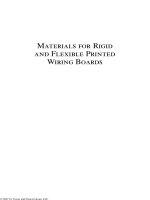
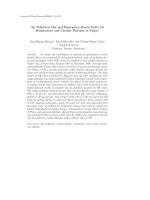
![ship stability for masters and mates [electronic resource]](https://media.store123doc.com/images/document/14/y/bj/medium_bjc1401370968.jpg)

